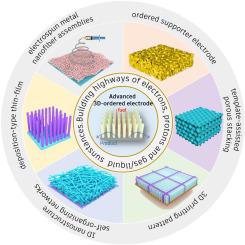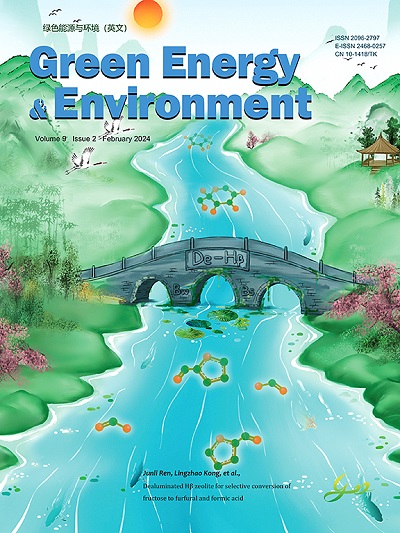用于PEMFC应用的先进3D有序电极:从结构特征和制造方法到催化剂层的可控设计
IF 10.7
1区 工程技术
Q1 CHEMISTRY, PHYSICAL
引用次数: 0
摘要
催化剂层(CLs)电极是质子交换膜燃料电池(pemfc)中膜电极组件(MEA)的关键部件。传统的pemfc电极由碳支撑、离子和铂纳米粒子组成,它们都浸在一起,并喷涂微米级厚度的氯离子。它们具有性能权衡,其中增加Pt负载导致丰富的三相边界区域的性能更高,但增加了电极成本。在实现其广泛商业化之前,必须克服重大挑战。文献研究表明,仅靠高性能催化剂是不可能实现性能和耐久性目标的,因此pemfc的mea中CLs架构的可控设计必须成为当前实现行业目标的重中之重。从这个角度来看,3D有序电极通过无支撑结构和超薄厚度规避了这个问题,同时减少了贵金属铂的负载。在此,我们深入讨论了动机,并总结了设计超低铂负载电极所需的cl结构特征。必须研究和描述3D订购CLs仍在进行中的关键问题。此外,总结了3D有序CLs结构电极的开发方法,包括材料设计、结构优化、制备技术和表征技术,并有望成为下一代用于pemfc的CLs。最后,本文总结了CL体系结构可能的研究方向,以应对未来的重大挑战。本文章由计算机程序翻译,如有差异,请以英文原文为准。

Advanced 3D Ordered Electrodes for PEMFC Applications: From Structural Features and Fabrication Methods to the Controllable Design of Catalyst Layers
The catalyst layers (CLs) electrode is the key component of the membrane electrode assembly (MEA) in proton exchange membrane fuel cells (PEMFCs). Conventional electrodes for PEMFCs are composed of carbon-supported, ionomer, and Pt nanoparticles, all immersed together and sprayed with a micron-level thickness of CLs. They have a performance trade-off where increasing the Pt loading leads to higher performance of abundant triple-phase boundary areas but increases the electrode cost. Major challenges must be overcome before realizing its wide commercialization. Literature research revealed that it is impossible to achieve performance and durability targets with only high-performance catalysts, so the controllable design of CLs architecture in MEAs for PEMFCs must now be the top priority to meet industry goals. From this perspective, a 3D ordered electrode circumvents this issue with a support-free architecture and ultrathin thickness while reducing noble metal Pt loadings. Herein, we discuss the motivation in-depth and summarize the necessary CLs structural features for designing ultralow Pt loading electrodes. Critical issues that remain in progress for 3D ordered CLs must be studied and characterized. Furthermore, approaches for 3D ordered CLs architecture electrode development, involving material design, structure optimization, preparation technology, and characterization techniques, are summarized and are expected to be next-generation CLs for PEMFCs. Finally, the review concludes with perspectives on possible research directions of CL architecture to address the significant challenges in the future.
求助全文
通过发布文献求助,成功后即可免费获取论文全文。
去求助
来源期刊

Green Energy & Environment
Energy-Renewable Energy, Sustainability and the Environment
CiteScore
16.80
自引率
3.80%
发文量
332
审稿时长
12 days
期刊介绍:
Green Energy & Environment (GEE) is an internationally recognized journal that undergoes a rigorous peer-review process. It focuses on interdisciplinary research related to green energy and the environment, covering a wide range of topics including biofuel and bioenergy, energy storage and networks, catalysis for sustainable processes, and materials for energy and the environment. GEE has a broad scope and encourages the submission of original and innovative research in both fundamental and engineering fields. Additionally, GEE serves as a platform for discussions, summaries, reviews, and previews of the impact of green energy on the eco-environment.
 求助内容:
求助内容: 应助结果提醒方式:
应助结果提醒方式:


